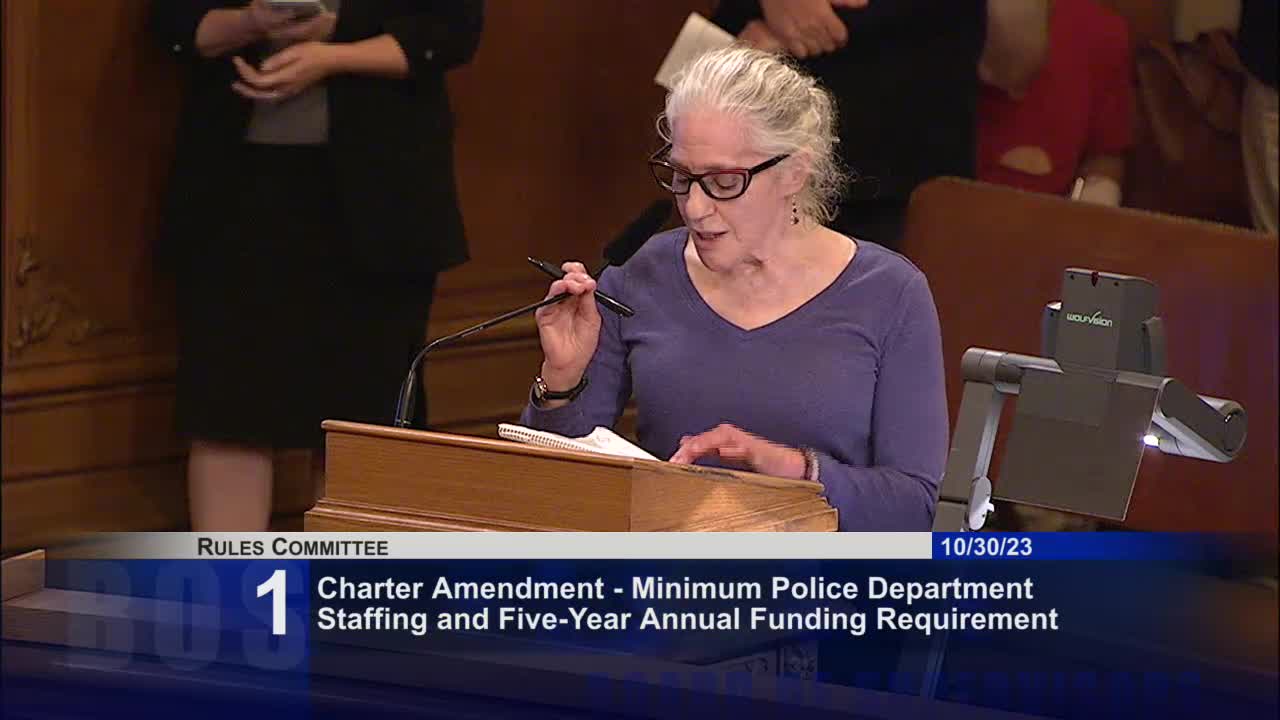San Francisco officials debate Dorsey's charter amendment on police staffing and public safety
October 30, 2023 | San Francisco County, California
This article was created by AI summarizing key points discussed. AI makes mistakes, so for full details and context, please refer to the video of the full meeting. Please report any errors so we can fix them. Report an error »

In a recent San Francisco County government meeting, discussions centered around public safety and the proposed charter amendment by Supervisor Dorsey, which aims to address staffing shortages within the San Francisco Police Department (SFPD). The meeting highlighted contrasting perspectives on how to tackle the city's pressing safety concerns, particularly regarding crime and homelessness.
Julia Rome, representing the San Francisco Travel Association, emphasized the critical need for enhanced police staffing to improve the perception of safety among residents and visitors. She argued that the current shortfall of officers has led to significant concerns about property crime and drug-related issues, which have been widely reported in international media. Rome urged the supervisors to support Dorsey's amendment, which would establish a minimum staffing requirement and allocate funds for recruitment over the next five years. She warned that failing to act could result in economic losses, as safety perceptions directly impact tourism and local businesses.
Conversely, Alan Cohen from San Francisco Adult Protective Services voiced strong opposition to the amendment. He argued that the focus should not be on increasing police presence but rather on addressing the root causes of issues such as homelessness and mental illness. Cohen highlighted recent legislative changes aimed at improving mental health treatment and expressed concern that diverting funds to the police would undermine essential services for vulnerable populations. He called for a more compassionate approach that prioritizes treatment over criminalization.
The meeting underscored a significant divide in approaches to public safety in San Francisco. On one side, there is a push for bolstering police resources to combat crime; on the other, a call for a more holistic strategy that addresses underlying social issues. As the city grapples with these challenges, the outcome of the discussions could have lasting implications for community safety and the well-being of its residents. The supervisors are now faced with the task of balancing these competing priorities as they consider the future of public safety in San Francisco.
Julia Rome, representing the San Francisco Travel Association, emphasized the critical need for enhanced police staffing to improve the perception of safety among residents and visitors. She argued that the current shortfall of officers has led to significant concerns about property crime and drug-related issues, which have been widely reported in international media. Rome urged the supervisors to support Dorsey's amendment, which would establish a minimum staffing requirement and allocate funds for recruitment over the next five years. She warned that failing to act could result in economic losses, as safety perceptions directly impact tourism and local businesses.
Conversely, Alan Cohen from San Francisco Adult Protective Services voiced strong opposition to the amendment. He argued that the focus should not be on increasing police presence but rather on addressing the root causes of issues such as homelessness and mental illness. Cohen highlighted recent legislative changes aimed at improving mental health treatment and expressed concern that diverting funds to the police would undermine essential services for vulnerable populations. He called for a more compassionate approach that prioritizes treatment over criminalization.
The meeting underscored a significant divide in approaches to public safety in San Francisco. On one side, there is a push for bolstering police resources to combat crime; on the other, a call for a more holistic strategy that addresses underlying social issues. As the city grapples with these challenges, the outcome of the discussions could have lasting implications for community safety and the well-being of its residents. The supervisors are now faced with the task of balancing these competing priorities as they consider the future of public safety in San Francisco.
View the Full Meeting & All Its Details
This article offers just a summary. Unlock complete video, transcripts, and insights as a Founder Member.
✓
Watch full, unedited meeting videos
✓
Search every word spoken in unlimited transcripts
✓
AI summaries & real-time alerts (all government levels)
✓
Permanent access to expanding government content
30-day money-back guarantee

